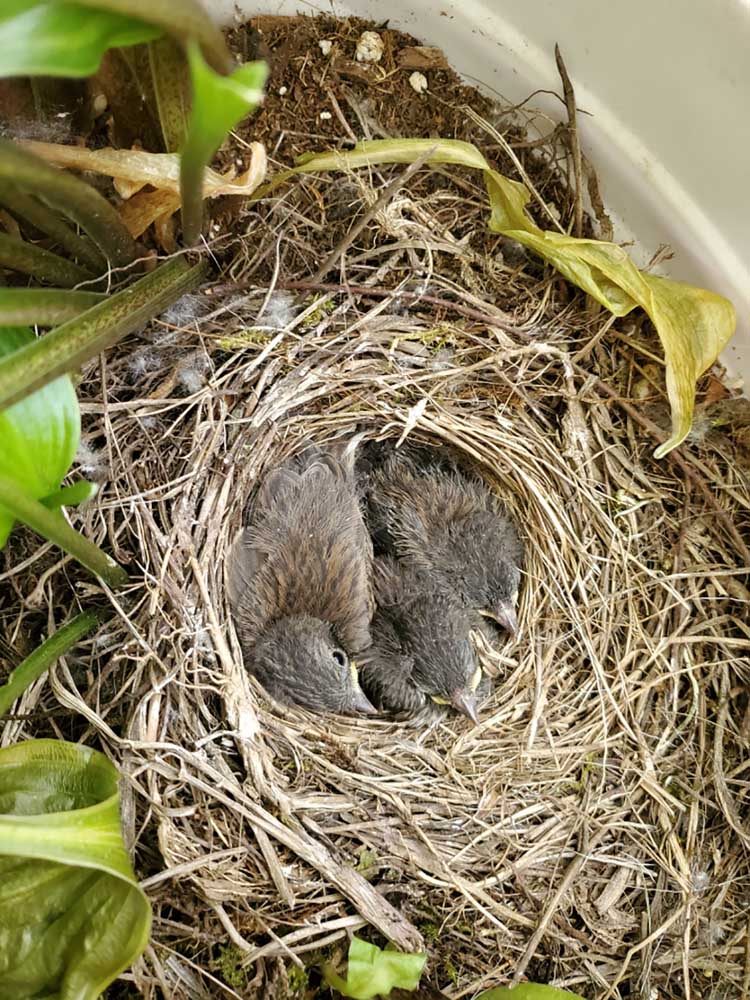Birding: More news from the nest
Published 3:54 pm Monday, July 18, 2022

- Lady Junco’s second brood. The three nestlings fledged on July 3rd a few days after this photo was taken.
Some birds are late nesters. The American goldfinch and the cedar waxwing are two species who nest later than most other species. Often this is because of the nesting material they typically use as a nest liner.
Trending
In the case of the goldfinch, fluff, from seed-bearing plants such as fireweed or thistle is always a favorite. The “fluff” is part of the going to seed process, so it comes later in the summer once flowering is over, and the plant goes to seed. Thus, their choice of habitat is highly influenced by the availability of nesting material and seeds which are the mainstay of their vegetarian diet. The Cornell Lab’s research indicates that goldfinch habitat is “weedy fields, open floodplains, and other overgrown areas, particularly with sunflower, aster, and thistle plants for food and some shrubs and trees for nesting.”
In the case of cedar waxwings, nesting usually begins in mid-June, but they will nest as late as the month of August which is much later than for most other songbirds. Waxwings begin late because they mainly feed fruit which is their main food source to their young. Fruit is typically unavailable until later in the summer. They do feed their nestlings insects but only for one or two days (Cornell Lab). They, then, quickly switch to putting the babies exclusively on a diet of fruit after that. Thus, their choice of habitat is highly influenced by the availability of fruit. They most often nest in locations where fruiting plants are found. This includes backyards and urban areas that feature ornamental berry trees as part of the landscape.
I have been seeing the female goldfinch and her chosen mate staying very close to one another of late. To me, this signaled “getting ready to nest behavior.” The literature suggests that the pair work together to choose a suitable nesting site. In the last few days, I have rarely seen only one of a pair. They are always together, and even perch very close to one another on the same branch. Once the site is chosen the female alone builds the nest in about six days. Yesterday I witnessed the female goldfinch of one pair tugging at the alpaca nesting ball of wool that I put our during spring and summer. It is a popular item in the yard because it makes such a soft and luxurious lining for a nest. Even the house sparrows go after it.
Trending
Cedar waxwings also perch close to one another when courting and feed each other little goodies. I have witnessed this behavior in the last few days. Like the goldfinch, the female cedar waxwing builds the nest which she usually completes in five or six days.
Second nestings are also in progress or just beginning. American male robins are still singing on territory and many parents are taking mouthfuls of worms and insects to their nestlings. Lady Junco successfully hatched three of the four eggs she laid in the Hosta Hotel for her second brood of the year. She was interesting to watch. Her behavior was just like science says it usually is. Shelley reports that Lady junco laid one egg a day, incubated the eggs for the required number of days and the nestlings fledged after 12 days in the nest. All of this as generally expected.
House sparrows have been seen gathering nesting materials lately. They seem to be well on their way to a second nesting. I have also observed some song sparrows still singing, while others are carrying beaks full of insects and other goodies to their probable second nests. Brewer’s blackbirds are also feeding nestlings which may belong to their second brood.
Soon, nesting season will be over, and the birds will begin to gather for their fall migration to their wintering grounds. Keep your eyes open for those feathered friends that are still feeding babies and those that are still sitting on eggs or nestlings. You may still see cedar waxwings feeding each other while courting. You might even find a late nest as far along as August.
Happy birding!









